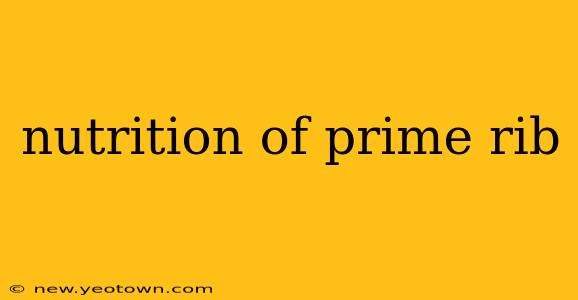Ah, prime rib. The king of roasts, the centerpiece of celebratory feasts, the epitome of decadent indulgence. But beyond its succulent texture and rich flavor, what's the nutritional story behind this culinary champion? Let's delve into the juicy details of prime rib nutrition, separating fact from fiction and answering those burning questions you might have.
What is the nutritional content of prime rib?
Prime rib, a cut from the rib section of beef, is undeniably rich. It's primarily composed of protein, fat, and a modest amount of other nutrients. A 3-ounce serving of cooked prime rib (approximately 85 grams) typically contains:
- Calories: Around 200-250 calories, depending on the cut and cooking method. Fattier cuts will naturally yield more calories.
- Protein: A significant source, providing approximately 20-25 grams per serving. This makes it a valuable protein source for muscle building and repair.
- Fat: This is where the variability lies. A leaner cut of prime rib will have less fat, while a well-marbled cut (with desirable intramuscular fat) will have a higher fat content. This can range from 10-20 grams of fat or more per serving. The fat content significantly impacts the overall calorie count.
- Saturated Fat: A concern for some, saturated fat makes up a portion of the total fat. Moderation is key, especially for individuals watching their cholesterol levels.
- Cholesterol: Prime rib contains cholesterol, contributing to the total dietary cholesterol intake. Again, mindful consumption is important.
- Vitamins and Minerals: Prime rib offers smaller amounts of various vitamins and minerals, including iron, zinc, and B vitamins.
Is prime rib healthy?
This is a question with no simple yes or no answer. Prime rib can certainly be part of a healthy diet, but its high fat and calorie content necessitates mindful consumption. It's not a food you should eat every day, but an occasional treat within a balanced eating plan.
How many calories are in a prime rib roast?
The calorie count of a prime rib roast varies dramatically depending on its size, the marbling (fat content), and the cooking method. A large roast will naturally contain far more calories than a smaller one. Accurate calorie estimation for a whole roast is difficult without precise measurements and knowledge of the specific cut.
How much prime rib should I eat?
Portion control is crucial when enjoying prime rib. Sticking to a 3-4 ounce serving can help manage calorie and fat intake. Consider balancing your meal with plenty of vegetables to create a more nutrient-rich and well-rounded plate.
What are the health benefits of prime rib?
While the high fat content might overshadow it, prime rib does offer some health benefits:
- High-Quality Protein: Essential for building and repairing tissues.
- Iron: Contributes to red blood cell production and oxygen transport.
- B Vitamins: Crucial for energy metabolism and various bodily functions.
- Zinc: Supports immune function and wound healing.
However, it's vital to remember that these benefits are best realized when prime rib is consumed sparingly as part of a balanced, varied diet.
Is prime rib good for weight loss?
Due to its high calorie and fat content, prime rib is generally not considered ideal for weight loss. While it does contain protein, a nutrient crucial for satiety, the overall caloric density makes it difficult to incorporate into a calorie-controlled weight loss plan without potentially hindering progress.
Ultimately, the nutritional value of prime rib depends heavily on the cut, portion size, and how it fits into your overall dietary pattern. Enjoy it responsibly as a special occasion treat rather than a regular dietary staple. Remember to consult with a registered dietitian or healthcare professional for personalized dietary advice.

